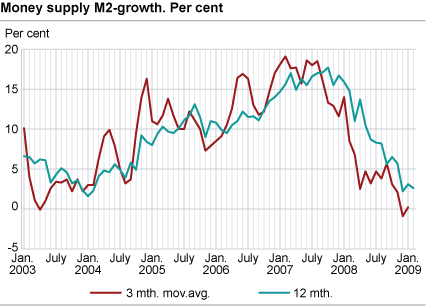Content
Published:
This is an archived release.
Continued low growth in money supply
The twelve-month growth in total money supply was 2.6 per cent to end-February, down from 3.1 per cent to end-January. Growth in base money, on the other hand, was record high, almost 150 per cent over the last twelve months.
The money supply amounted to NOK 1 500 billion at end-February, down from NOK 1 504 billion at end- January. The growth in money supply has fallen dramatically since December 2007, when it was 16.7 per cent.
Continued negative growth for non-financial enterprise money supply
Non-financial enterprise money supply amounted to NOK 500 billion at end-February. The twelve-month growth was -3.1 per cent, down from -1.2 per cent to the previous month, and has been negative since last November. Non-financial enterprise money supply growth was higher than 30 per cent as recently as April 2007.
Household money supply pulls down the growth
At end-February, more than half (NOK 803 billion) of the broad monetary aggregate was owned by households. The twelve-month growth in household money supply decreased from 7.4 per cent to 7.0 per cent during February. The growth in household money supply was still slightly higher than the growth in household gross domestic debt, which was 6.7 per cent to end-February, as shown by the credit indicator C2 . For more information on the financial position of households, see the financial accounts in the national accounts .
| September 2008 | October 2008 | November 2008 | December 2008 | January 2009 | February 2009 | ||||||||||||||||||||||||||||||||||
|---|---|---|---|---|---|---|---|---|---|---|---|---|---|---|---|---|---|---|---|---|---|---|---|---|---|---|---|---|---|---|---|---|---|---|---|---|---|---|---|
| M0 - 12 mth. | 21.6 | 59.8 | 115.8 | 43.0 | 103.4 | 147.1 | |||||||||||||||||||||||||||||||||
| M1 - 12 mth. | -2.4 | -3.9 | -4.2 | -5.2 | -4.5 | -3.9 | |||||||||||||||||||||||||||||||||
| M2 - 12 mth. | 5.6 | 6.5 | 5.7 | 2.2 | 3.1 | 2.6 | |||||||||||||||||||||||||||||||||
| M2 - 3 mth. moving average | 5.7 | 3.1 | 2.1 | -0.9 | 0.2 | ||||||||||||||||||||||||||||||||||
| M2 households - 12 mth. | 6.9 | 7.3 | 7.1 | 8.0 | 7.4 | 7.0 | |||||||||||||||||||||||||||||||||
| M2 non-financial enterprises - 12 mth. | 2.6 | 0.1 | -1.3 | -5.1 | -1.2 | -3.1 | |||||||||||||||||||||||||||||||||
Record high base money
Base money (see below) amounted to NOK 160 billion at end-February. This is the highest recorded monetary base since December 1992, when this type of data was first stored. The fact that base money was so high, must be seen in connection with banks having current accounts with Norges Bank for NOK 110 billion.
The banks’ high current accounts with Norges Bank is in turn connected with a dysfunctional money market caused by the financial crisis. Base money increased considerably from September to October last year and has since amounted to more than NOK 140 billion. The twelve-month growth in M0 was 147.1 per cent to end-February, which is also a record high.
|
The money supply (broad monetary aggregate) M2 consists of notes and coins, unrestricted bank deposits, certificates of deposit and units in money market funds owned by the money-holding sector i.e. households, non-financial enterprises, municipalities and financial enterprises other than state lending institutions, banks and money market funds. |
|
The base money (M0) is defined as banks and the money-holding sector's (see above) notes and coins and deposits with Norges Bank. Banks’ deposits with Norges Bank comprise current account (sight) deposits and fixed rate (time) deposits (F-deposits), from Norges Bank’s monthly balance sheet. |
The statistics is published with Monetary aggregates.
Contact
-
Statistics Norway's Information Centre
E-mail: informasjon@ssb.no
tel.: (+47) 21 09 46 42

